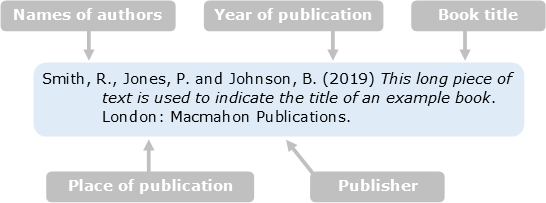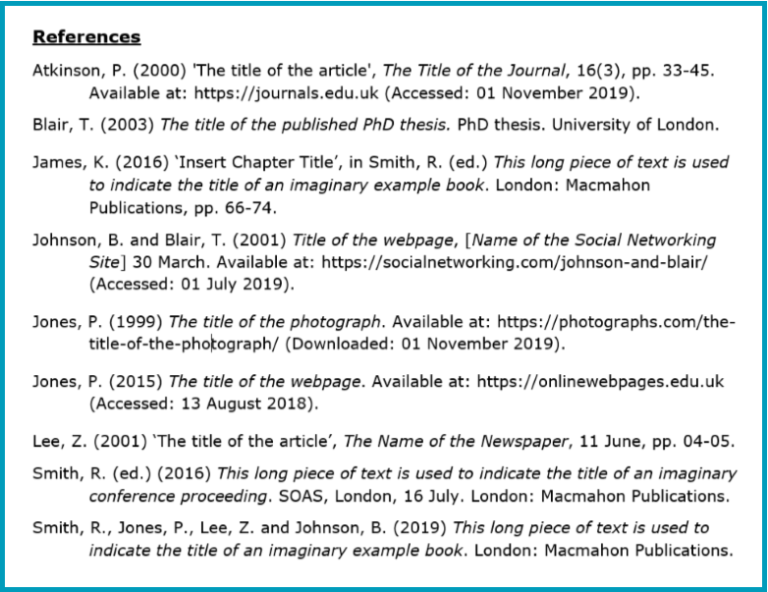Do Harvard reference lists have formatting rules?

This is the second and final chapter about Writing Harvard Reference Lists. To complete this reader, read each chapter carefully and then unlock and complete our materials to check your understanding.
– Review the five questions that students should ask themselves before they begin referencing
– Consider the rules of formatting, order and display which are connected with the Harvard referencing style
– Use activities worksheets to check progress and understanding and improve English proficiency
Before you begin reading...
-
video and audio texts
-
knowledge checks and quizzes
-
skills practices, tasks and assignments
Chapter 2

In this second chapter on writing Harvard reference lists, we turn our attention next to the smaller details of referencing accuracy, answering questions about the rules of formatting, display and order that so commonly cause issues or confusion for students. After completing this chapter and its related worksheets, you may wish to also check our short reader on referencing sources in Harvard. Then you will have the complete knowledge of how to both reference a wide array of printed and digital source types in the Harvard style and arrange those references into reference lists.
What should I consider first?
When attempting to create an accurate and comprehensive Harvard reference list, there are a number of questions that students should first ask themselves:
- Have I definitely cited this source in my assignment? Only sources which have been cited directly in your work should be included in a reference list.
- What is the source type I need to reference? The type of source being referenced such as a book or newspaper will determine the necessary reference elements.
- Which reference elements are necessary? There are many elements that might have to be referenced, such as the publisher or the year of publication.
- How should those reference elements be ordered? Sometimes how the elements are ordered depends entirely on the source type being referenced.
- Are there any special formatting requirements? Aspects such as spacing, italics and punctuation are very important when referencing accurately.
Which formatting rules are most important?
When writing your references, it’s critical also that you follow the many rules of formatting which are an integral part of the Harvard style. This usually includes rules of punctuation, capitalisation, italicisation and spacing. The best way to do this is to take an example reference for the source type you wish to include in your assignment, deconstruct that reference into its key elements and carefully observe and replicate the formatting. Take for example our reference from Chapter 1:

If we focus on only the first reference element here, the Name of authors, we can see that the first author’s name has been formatted in the following way:

To then add every additional name to the reference, the following structure is used:

Likewise, for the final two elements, the Place of publication and the Publisher, the Harvard style dictates that the following formatting should be carefully followed:

What are the rules for displaying reference lists?
Almost as important as correctly formatting your Harvard references is correctly displaying your reference list. Thankfully, there are four simple rules which can be followed to guarantee that your tutor is impressed:
- Include a title at the top of your list, such as ‘References’
- Place your reference list on a fresh blank page at the end of your assignment
- Start every reference on a new line and consider using hanging indentation to separate those references more clearly
- Correctly format your references according to the font types, font sizes and spacing requirements of your course

Do you notice these four rules in action in our example reference list from Chapter 1?

How should Harvard reference lists be ordered?
Finally, don’t forget that the order of your references in your reference list is important too. What do you notice about the example list above? How have those sources been ordered? Hopefully you can tell that most references are ordered alphabetically from A to Z, with ‘Atkinson’ coming first and ‘Smith’ being placed last. But what should a student do when two different sources have the same authors, such as Jones (1999) and Jones (2015)? Clearly, in this instance, the Harvard style recommends a chronological ordering as an alphabetical one is insufficient.
For more information about these topics, consider studying our general reader on references and reference lists. Otherwise, good work on completing this short reader and best of luck with completing our Chapter 2 Worksheet to check your knowledge, progress and English proficiency.
To reference this reader:
Academic Marker (2022) Writing Harvard Reference Lists. Available at: https://academicmarker.com/academic-guidance/referencing/referencing-styles/harvard-style/writing-harvard-reference-lists/ (Accessed: Date Month Year).
Downloadables
Once you’ve completed both chapters in this short reader about Writing Harvard Reference Lists, you might then wish to download our Chapter Worksheets to check your progress or print for your students. These professional PDF worksheets can be easily accessed for only a few Academic Marks.
Chapter 1 explores the topic: Do Harvard style academic essays use references? Our Chapter 1 Worksheet (containing guidance, activities and answer keys) can be accessed here at the click of a button.
Chapter 2 explores the topic: Do Harvard reference lists have formatting rules? Our Chapter 2 Worksheet (containing guidance, activities and answer keys) can be accessed here at the click of a button.
To save yourself 1 Marks, click on the button below to gain unlimited access to all of our Writing Harvard Reference Lists Chapter Worksheets. This All-in-1 Pack includes every chapter, activity and answer key related this topic in one handy and professional PDF.
Collect Academic Marks
-
100 Marks for joining
-
25 Marks for daily e-learning
-
100-200 for feedback/testimonials
-
100-500 for referring your colleages/friends